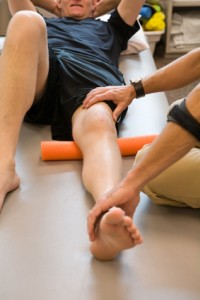It’s been seven weeks since the technologically advanced model of Johnson & Johnson-Depuy knee joints were installed to replace Mother Nature. Over that time, I’ve started to mark significant events in my trek toward full, pain-free mobility by the number of days since surgery. It’s not unlike the Lewis and Clark Expedition. Anybody who has had a joint replaced knows of what I speak.
Day 1
I was told this would occur, but I really didn’t believe it. The polite and encouraging staff at Central Louisiana Surgical Hospital (CLSH) are attaching a harness and adjusting a walker. I’m to stand—and walk—the first day after surgery. Mother deer give their fawns more time than this. It seems impossible, and I’m still trying to cast off the effects of anesthesia.
After a few furtive steps I realize that there’s no knee pain, at least not the kind from which I suffered for nearly three decades. The pain is different, already better. I’m moving like a sloth, but I’m oozing ahead on my own with physical therapist John Davidson only inches away in case I falter. The staff is actually cheering. A few dozen steps later I lurch back into bed with considerably more confidence than a few minutes earlier.
Day 3
The past 48 hours have been extremely uncomfortable, but only because pain killers don’t have much effect on me. But it’s on this day that suddenly, for about 30 minutes, I abruptly felt normal. It was a short-lived parole from pain, but it was genuine and it was glorious and it was a life buoy.
Even though the new surgical hospital had been open only a few weeks and I was the first double-knee replacement patient, the efficiency and attentiveness of the staff—medical and non-medical—was impressive and appreciated. My family and friends said the food was terrific, varied and came in substantial portions. As for my impression, I refused to leave until my lunch of baked tilapia had been served by the Luby’s staff at CLSH.
It was also on this day that I was transferred to the inpatient rehabilitation unit at Cabrini Hospital without the slightest encumbrance of red tape.
Day 4
Full-time therapy began this day in my new location, 90 minutes in the morning and another 90 in the afternoon. Much has to be relearned, even the basics of how to maneuver to a toilet or take a shower. This was accomplished with assistance from Lane, a very patient, sensitive and clever occupational therapist. Little in my life has felt as good as that first post-surgery shower.
Day 5
I’m puzzled over what the physical therapists call “muscle memory loss.” This isn’t a case of muscles losing significant strength over the past few days of relative inactivity. Rather, it’s a reaction to the trauma of surgery, a sort of suspension from normal function. It’s also due to the fact that these muscles have not worked normally for many years.
There’s a new range of motion to be “learned” with the elimination of the confining bone spurs and the correcting realignment of the knee joints during surgery. It was knee motion I have not had for many years. My left leg in particular, which had undergone several previous surgeries in response to a variety of injuries, was adjusting to a new “natural” environment. The bottom line is there’s a lot of catching up to do.
Day 10
I’ve been released from the rehabilitation hospital after my quest to exceed the expectations of physical therapists Olive and Christy and the best hospital nurse I’ve ever had, Tammy. It’s been an arduous but productive week. If you face bilateral joint replacements, my advice is to demand some time in one of the local rehabilitation hospitals. Of course, that opportunity is all insurance driven.
Day 18
This is the day that I ditch the shower bench and carefully stand by myself in the shower. It’s liberating, and it’s another psychological booster shot. The relief for my wife was nearly as palpable as my own.
Day 21
It’s back to Mid State Orthopaedic for a post-surgery look-see. Drs. Rich and Texada are pleased with the X-rays, which show a significantly improved alignment of the new joints and their placement on the bones to which they are attached. These are good signs.
Day 28
I cast aside the walker. I’ve taken a few tentative steps without it for a few days, but this is the day that I permanently dissolve the partnership. A lengthy walking stick is now my companion as I make the transition from six “legs” to three. Derisively good-natured friends start calling me Moses. My brief attempt to part Red River fails, and if there have been any miracles, they can’t be attributed to me.
Day 35
After three weeks of out-patient physical therapy I’m told that I’m now allowed to drive. Maybe this falls in the minor miracle category. It’s nothing in which the Vatican would be interested, but it’s significant to me. I start carrying a St. Christopher medal (patron saint of travel). I’m not Catholic, but I am cautious.
Day 40
I return to a portion of my pre-surgery workout routine, getting reacquainted with two types of stationary bicycles and an elliptical strider. I’m able to perform at perhaps 50 percent of my usual speed, resistance and time, but after a stiff and somewhat painful start, there is noticeable loosening in both knees. It may be my imagination, but I almost “hear” the “recognition” of normal range of motion by my joints. This is very good.
Also, the regulars in the gym come over to guffaw and admire my scars and offer the usual male bantering and locker room humor and encouragement. The attractive females mostly ignore me as usual. Hey, things really are returning to normal.










